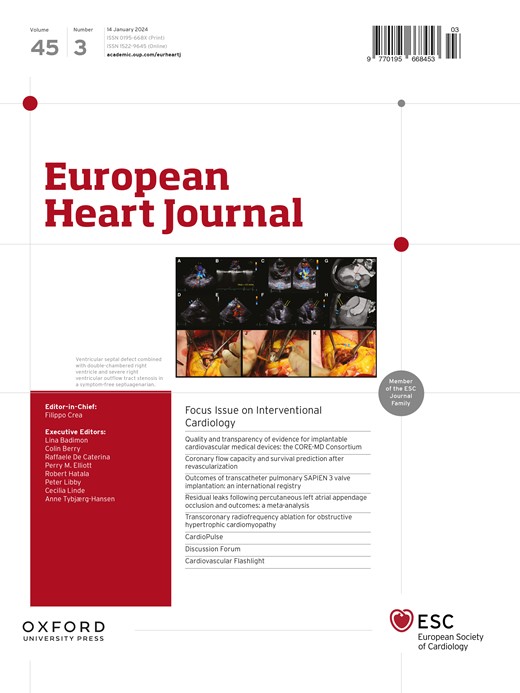Efficacy of aficamten in patients with obstructive hypertrophic cardiomyopathy and mild symptoms: results from the SEQUOIA-HCM trial.
IF 35.6
1区 医学
Q1 CARDIAC & CARDIOVASCULAR SYSTEMS
引用次数: 0
Abstract
BACKGROUND AND AIMS Patients with obstructive hypertrophic cardiomyopathy (oHCM) treated with aficamten in SEQUOIA-HCM (NCT05186818) demonstrated marked improvement in symptoms and functional capacity. This analysis explores whether oHCM and mild symptoms patients experience similar clinical benefits with aficamten as patients with more advanced limitations. METHODS Patients in SEQUOIA-HCM (N = 282) were grouped at baseline according to symptom severity. Mild symptoms (n = 118) were defined as New York Heart Association (NYHA) class II and Kansas City Cardiomyopathy Questionnaire Clinical Summary Score (KCCQ-CSS) ≥ 80, and moderate to severe symptoms (n = 150) as NYHA class II/III/IV and KCCQ-CSS <80. Primary endpoint was change in peak oxygen uptake (pVO2) from baseline to Week 24; secondary endpoints included change in NYHA class, KCCQ-CSS, outflow tract gradients, and N-terminal pro-B-type natriuretic peptide (NT-proBNP). RESULTS In aficamten-treated patients, change at Week 24 was not different between moderate to severe (1.8 mL/kg/min; n = 71) and mild (1.6 mL/kg/min; n = 62) symptom groups (P = .8). Likewise, the change in secondary endpoints (NYHA class, resting or Valsalva gradients, and NT-proBNP) did not differ significantly between the two symptom groups. Both groups experienced statistically significant improvements in KCCQ-CSS, but the extent of improvement was greater in the advanced symptom group (P = .02 for interaction). Treatment-emergent serious adverse events were infrequent in both groups. CONCLUSIONS Patients with oHCM and mild symptoms treated with aficamten achieved significant improvement across a range of clinically relevant outcomes and generally similar to patients with more advanced symptoms. Less severely symptomatic patients could be considered for aficamten treatment.阿菲康坦对梗阻性肥厚性心肌病和轻度症状患者的疗效:来自SEQUOIA-HCM试验的结果
在SEQUOIA-HCM (NCT05186818)中,使用aficamten治疗梗阻性肥厚性心肌病(oHCM)的患者表现出症状和功能能力的显著改善。该分析探讨了oHCM和轻度症状患者是否与更严重的局限性患者相比,使用aficamten可以获得相似的临床益处。方法282例sequia - hcm患者在基线时根据症状严重程度分组。轻度症状(n = 118)定义为纽约心脏协会(NYHA) II级和堪萨斯城心肌病问卷临床总结评分(KCCQ-CSS)≥80,中度至重度症状(n = 150)定义为NYHA II/III/IV级和KCCQ-CSS <80。主要终点是从基线到第24周的峰值摄氧量(pVO2)的变化;次要终点包括NYHA等级、KCCQ-CSS、流出道梯度和n端前b型利钠肽(NT-proBNP)的变化。结果aficamten治疗的患者在第24周时,中重度(1.8 mL/kg/min, n = 71)和轻度(1.6 mL/kg/min, n = 62)症状组间的差异无统计学意义(P = 0.8)。同样,次要终点(NYHA分级、静息或Valsalva梯度和NT-proBNP)的变化在两个症状组之间也没有显著差异。两组在KCCQ-CSS方面均有统计学意义的改善,但晚期症状组的改善程度更大(相互作用P = 0.02)。治疗后出现的严重不良事件在两组中都不常见。结论:轻度症状的oHCM患者经阿非曲坦治疗后,在一系列临床相关结果上均取得了显著改善,且与症状较晚期的患者基本相似。症状较轻的患者可考虑进行药物治疗。
本文章由计算机程序翻译,如有差异,请以英文原文为准。
求助全文
约1分钟内获得全文
求助全文
来源期刊

European Heart Journal
医学-心血管系统
CiteScore
39.30
自引率
6.90%
发文量
3942
审稿时长
1 months
期刊介绍:
The European Heart Journal is a renowned international journal that focuses on cardiovascular medicine. It is published weekly and is the official journal of the European Society of Cardiology. This peer-reviewed journal is committed to publishing high-quality clinical and scientific material pertaining to all aspects of cardiovascular medicine. It covers a diverse range of topics including research findings, technical evaluations, and reviews. Moreover, the journal serves as a platform for the exchange of information and discussions on various aspects of cardiovascular medicine, including educational matters.
In addition to original papers on cardiovascular medicine and surgery, the European Heart Journal also presents reviews, clinical perspectives, ESC Guidelines, and editorial articles that highlight recent advancements in cardiology. Additionally, the journal actively encourages readers to share their thoughts and opinions through correspondence.
 求助内容:
求助内容: 应助结果提醒方式:
应助结果提醒方式:


